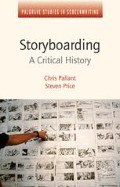Abstract
The pivotal place that William Cameron Menzies today occupies in the history of storyboarding initially derived from common perceptions about the role of storyboarding in the making of Gone with the Wind (1939), and the assumption that the pre-production of the film was significantly influenced by the Disney studio’s innovations in creating Snow White and the Seven Dwarfs. Menzies, however, had been working on related approaches to film design since the 1920s, and Selznick tested the waters by asking him to work first on a smaller-scale film for SIP, The Adventures of Tom Sawyer (1938). By 29 July 1937 the producer was envisaging that Menzies ‘will be able to do a broken-down sketch script of the entire production’ of Gone with the Wind,1 and as a result, the claim continues to be made that the film was ‘completely storyboarded’.2 Supporting evidence can be drawn from the surviving materials, the most frequently cited being an extensive sequence of images depicting the burning of Atlanta.
Access this chapter
Tax calculation will be finalised at checkout
Purchases are for personal use only
Preview
Unable to display preview. Download preview PDF.
Notes
Unless noted, quotations from David O. Selznick’s memos are from Rudy Behlmer, (ed.), Memo from David O. Selznick (New York: Viking, 1972).
Alan David Vertrees, Selznick’s Vision: Gone with the Wind and Hollywood Filmmaking (Austin: University of Texas Press, 1997), p. 59.
Scot Holton and Robert Skotak, ‘William Cameron Menzies: A Career Profile’, Fantascene 4 (1978), p. 5.
Paul Rotha, ‘The Art Director and the Composition of the Scenario’, Close Up (May 1930), pp. 379–380.
David Bordwell, ‘William Cameron Menzies: One Forceful, Impressive Idea’, March 2010, accessed 24 January 2015, retrieved from http://www.davidbor-dwell.net/essays/menzies.php#_Ednref9.
Richard Sylbert and Sylvia Townsend, Designing Movies: Portrait of a Hollywood Artist (Westport, CT: Praeger, 2006), p. 34.
Charles Higham, interview with James Wong Howe, Hollywood Cameramen: Sources of Light (Bloomington: Indiana University Press, 1970); quoted in Sylbert, p. 32.
Ezra Goodman, ‘Production Designing’, American Cinematographer (March 1945), p. 82.
For a discussion of the use of this form in Hollywood films of this period, see Steven Price, A History of the Screenplay (Basingstoke: Palgrave, 2013), pp. 149–151.
Vertrees, Selznick’s Vision; Steve Wilson, The Making of Gone with the Wind (Austin: University of Texas Press, 2014). In addition, very informative studies are provided in Rudy Behlmer’s audio commentary accompanying the 65th Anniversary DVD release in 2005, and the made-for-television documentary The Making of a Legend: Gone With the Wind (1988), written by David Thomson, also included in the 2005 DVD release. Factual information in the following discussion is derived from these sources. Unless noted, quotations from.
David O. Selznick’s memos are from Rudy Behlmer, (ed.), Memo from David O. Selznick (New York: Viking, 1972).
Vincent LoBrutto, By Design: Interviews with Film Production Designers (Westport, CT: Praeger, 1992), p. xii.
Quoted in Rudy Behlmer, (ed.), Memo from David O. Selznick (New York: Viking, 1972), p. 151.
Quoted in Alan David Vertrees, ‘Reconstructing the “Script in Sketch Form”: An Analysis of the Narrative Construction and Production Design of the Fire Sequence in Gone with the Wind’, Film History 3 (1989), p. 100, n. 5.
Alan David Vertrees, ‘Reconstructing the “Script in Sketch Form”: An Analysis of the Narrative Construction and Production Design of the Fire Sequence in Gone with the Wind’, Film History 3 (1989), p. 91.
Steve Wilson, The Making of Gone with the Wind (Austin: University of Texas Press, 2014).
Kristina Jaspers, ‘Zur Entstehungsgeschichte und Funktion des Storyboards’, in Katharina Henkel, Kristina Jaspers, and Peter Mänz (eds), Zwischen Film und Kunst: Storyboards von Hitchcock bis Spielberg (Bielefeld: Kerber, 2012), p. 15
Frank S. Nugent: ‘Gone with.’ Etc – or the Making of a Movie, in: The New York Times Magazine, 10 December 1939, p. 17.
Jaspers, p. 16. The photograph is reproduced in Katharina Henkel, Kristina Jaspers, and Peter Mänz (eds), Zwischen Film und Kunst: Storyboards von Hitchcock bis Spielberg (Bielefeld: Kerber, 2012), pp. 48–49.
A detailed discussion of the uses of, and technical difficulties presented by, the use of Technicolor in the film is presented in Scott Higgins, Harnessing the Technicolor Rainbow: Color Design in the 1930s (Austin: University of Texas Press, 2007), pp. 172–207.
Author information
Authors and Affiliations
Copyright information
© 2015 Chris Pallant and Steven Price
About this chapter
Cite this chapter
Pallant, C., Price, S. (2015). William Cameron Menzies, Alice in Wonderland, and Gone with the Wind . In: Storyboarding. Palgrave Studies in Screenwriting. Palgrave Macmillan, London. https://doi.org/10.1057/9781137027603_4
Download citation
DOI: https://doi.org/10.1057/9781137027603_4
Publisher Name: Palgrave Macmillan, London
Print ISBN: 978-1-349-57323-3
Online ISBN: 978-1-137-02760-3
eBook Packages: Palgrave Media & Culture CollectionLiterature, Cultural and Media Studies (R0)

